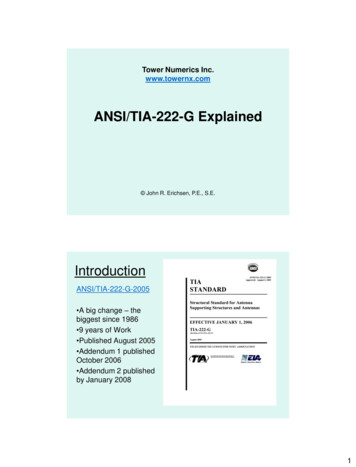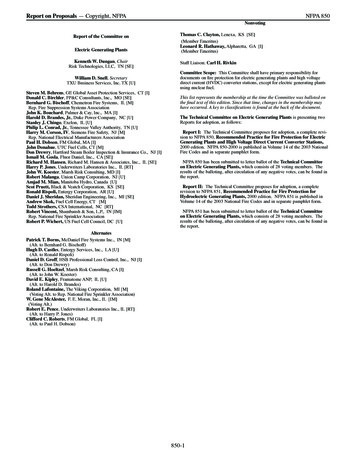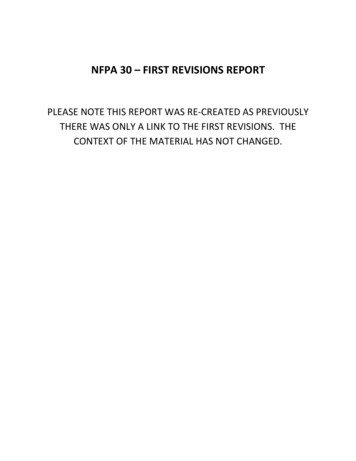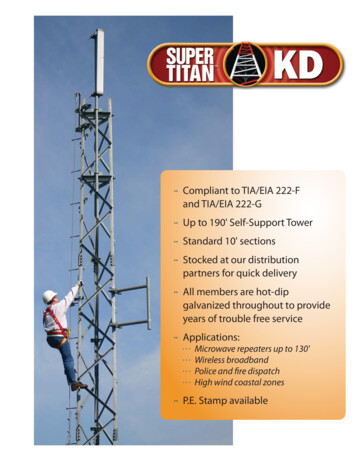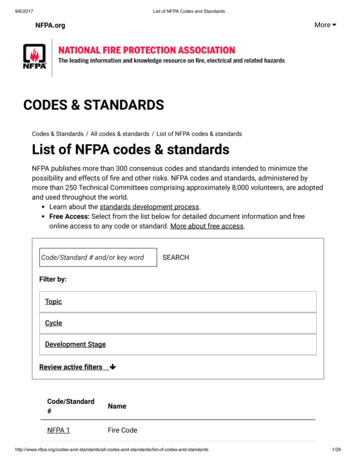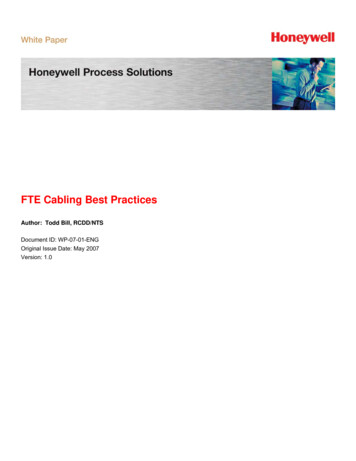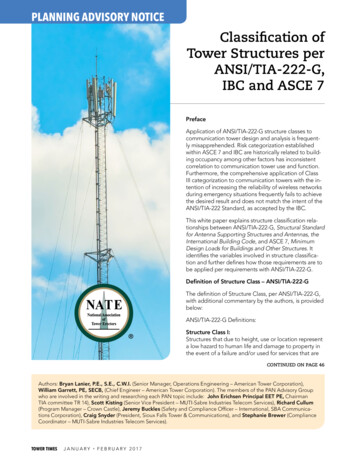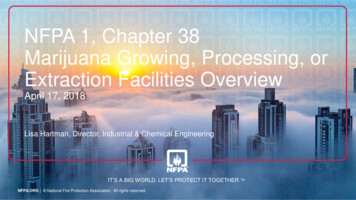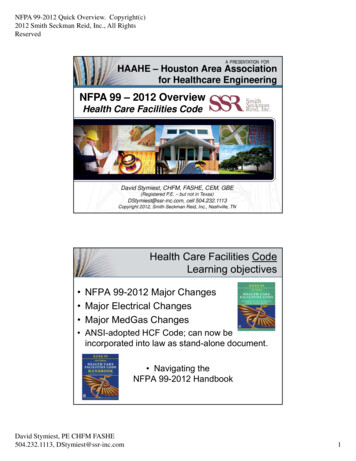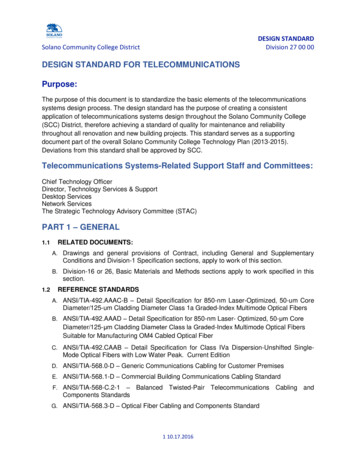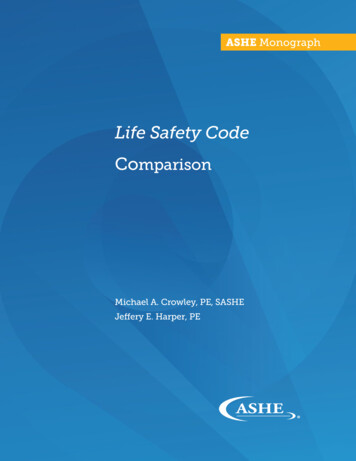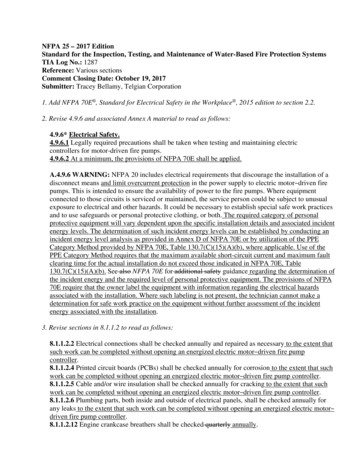
Transcription
NFPA 25 – 2017 EditionStandard for the Inspection, Testing, and Maintenance of Water-Based Fire Protection SystemsTIA Log No.: 1287Reference: Various sectionsComment Closing Date: October 19, 2017Submitter: Tracey Bellamy, Telgian Corporation1. Add NFPA 70E , Standard for Electrical Safety in the Workplace , 2015 edition to section 2.2.2. Revise 4.9.6 and associated Annex A material to read as follows:4.9.6* Electrical Safety.4.9.6.1 Legally required precautions shall be taken when testing and maintaining electriccontrollers for motor-driven fire pumps.4.9.6.2 At a minimum, the provisions of NFPA 70E shall be applied.A.4.9.6 WARNING: NFPA 20 includes electrical requirements that discourage the installation of adisconnect means and limit overcurrent protection in the power supply to electric motor–driven firepumps. This is intended to ensure the availability of power to the fire pumps. Where equipmentconnected to those circuits is serviced or maintained, the service person could be subject to unusualexposure to electrical and other hazards. It could be necessary to establish special safe work practicesand to use safeguards or personal protective clothing, or both. The required category of personalprotective equipment will vary dependent upon the specific installation details and associated incidentenergy levels. The determination of such incident energy levels can be established by conducting anincident energy level analysis as provided in Annex D of NFPA 70E or by utilization of the PPECategory Method provided by NFPA 70E, Table 130.7(C)(15)(A)(b), where applicable. Use of thePPE Category Method requires that the maximum available short-circuit current and maximum faultclearing time for the actual installation do not exceed those indicated in NFPA 70E, Table130.7(C)(15)(A)(b). See also NFPA 70E for additional safety guidance regarding the determination ofthe incident energy and the required level of personal protective equipment. The provisions of NFPA70E require that the owner label the equipment with information regarding the electrical hazardsassociated with the installation. Where such labeling is not present, the technician cannot make adetermination for safe work practice on the equipment without further assessment of the incidentenergy associated with the installation.3. Revise sections in 8.1.1.2 to read as follows:8.1.1.2.2 Electrical connections shall be checked annually and repaired as necessary to the extent thatsuch work can be completed without opening an energized electric motor–driven fire pumpcontroller.8.1.1.2.4 Printed circuit boards (PCBs) shall be checked annually for corrosion to the extent that suchwork can be completed without opening an energized electric motor–driven fire pump controller.8.1.1.2.5 Cable and/or wire insulation shall be checked annually for cracking to the extent that suchwork can be completed without opening an energized electric motor–driven fire pump controller.8.1.1.2.6 Plumbing parts, both inside and outside of electrical panels, shall be checked annually forany leaks to the extent that such work can be completed without opening an energized electric motor–driven fire pump controller.8.1.1.2.12 Engine crankcase breathers shall be checked quarterly annually.
8.1.1.2.16 All controls and power wiring connections shall be checked annually and repaired asnecessary to the extent that such work can be completed without opening an energized electricmotor–driven fire pump controller.8.1.1.2.21 The accuracy of pressure gauges and sensors shall be inspected annually and replaced orrecalibrated when more than 5 percent out of calibration to the extent that such work can becompleted without opening an energized electric motor–driven fire pump controller.4. Revise Table 8.1.1.2 to read as follows:Table 8.1.1.2 Summary of Fire Pump Inspection, Testing, and ntAnnually8.3.6.4Cable/wire insulationAnnually8.1.1.2.5Diesel pump systemWeekly8.2.2(4)Electric pump systemWeekly8.2.2(3)Engine crankcase breatherAnnually8.1.1.2.12Exhaust system and drain condensate trapAnnually8.1.1.2.13Flexible hoses and connectionsAnnually8.1.1.2.11Fuel tank vents and overflowAnnually8.1.1.2.10Plumbing parts – inside and outside of panelsAnnually8.1.1.2.6Printed circuit board corrosion (PCBs)Annually8.1.1.2.4PumpWeekly8.2.2(2)Pump house/roomWeekly8.2.2(1)Shaft movement or endplay while runningAnnually8.1.1.2.1Steam pump systemWeekly8.2.2(5)Suction screensAnnually8.3.3.712Automatic transfer switch and emergency/standbygeneratorsPer NFPA 1108.3.6.1 and 8.3.6.2Diesel engine–driven fire pumpWeekly8.3.1.1Diesel fuel testingAnnually/Semiannually8.3.4Electric motor–driven fire pumpWeekly/monthly8.3.1.2Electronic control module (ECM)Annually8.3.3.13Fire pump alarm signalsAnnually8.3.3.510TestFuel tank, float switch, and supervisory signal for interstitialQuarterlyspace8.1.1.2.7Main relief valveAnnually8.3.3.38Power transfer switchAnnually8.3.3.49Pump houseroom environmental conditions8.3.6.3
ItemFrequencyReferencePump operation (no flow)Weekly/monthly8.3.1Pump performance (flow)Annually8.3.3Supervisory signal for high cooling water .2.15Circulating water filterAnnually8.1.1.2.20Control and power wiring connectionsAnnually8.1.1.2 16ControllerPer manufacturer8.5Diesel active fuel maintenance systemAnnually or per manufacturerrecommendation8.3.4.3Diesel engine systemPer manufacturer8.5Electric motor and power systemPer manufacturer8.5Electrical connectionsAnnually8.1.1.2.2Engine lubricating oilAnnually or 50 operating hours8.1.1.2.17Engine oil filterAnnually or 50 operating hours8.1.1.2.18Fuel tank – check for water and foreign materialsAnnually8.1.1.2.9Measure back pressure on engine turboAnnually8.1.1.2.14Pressure gauges and sensorsAnnually8.1.1.2.21Pump and motor bearings and couplingAnnually or as required8.51.1.2.3Sacrificial anodeAnnually8.1.1.2.19Maintenance5. Revise the Electrical System section of Table A.8.1.1.2 for the following line items to read asfollows:Tighten electrical connections as necessaryCalibrate pressure switch settings*Voltmeter and ammeter for accuracy (5%)Any corrosion on printed circuit boards (PCBs)*Any cracked cable/wire insulation*Any leaks in plumbing parts*Any signs of water on electrical llyAnnuallyAnnually* Required only where the extent of such work can be completed without the opening of an energizedelectric motor–driven fire pump controller.6. Revise 8.3.2.8(2) to read as follows:8.3.2.8 The pertinent visual observations or adjustments specified in the following checklists shallbe conducted while the pump is idle:
(1) Record the system suction and discharge pressure gauge readings.(2) For pumps that use electronic pressure sensors to control the fire pump operation, record thecurrent pressure and the highest and the lowest pressure shown on the fire pump controller eventlog where such information is available without having to open an energized electric motor–driven fire pump controller.(3) If the highest or lowest pressure is outside of the expected range, record all information fromthe event log that helps identify the abnormality.7. Delete 8.3.3.2.1 in its entirety, and revise 8.3.3.2.2, and renumber subsequent paragraphs to readas follows:8.3.3.2.1 Voltage and amperage readings on fire pump controllers that meet the following criteriashall be permitted in lieu of calibrated voltage and / or amperage meters:(1) The fire pump controller shall have been factory calibrated and adjusted to 3 percent.(2) The voltage reading shall be within 5 percent of the rated voltage.8.3.3.2.21 Except as permitted in 8.3.3.2.1, cCalibrated test equipment shall be provided todetermine net pump pressures, rate of flow through the pump, volts and ampere, and speed.8.3.3.2.21.1 Calibrated 8.3.3.2.21.2 Gauges 8.3.3.2.21.3 Flow 8. Revise 8.3.3.7(2)(a) to read as follows:8.3.3.7 The pertinent visual observations, measurements, and adjustments specified in the followingchecklists shall be conducted annually while the pump is running and flowing water under thespecified output condition: (2) At each flow condition, the procedure is as follows:(a) Where an external means is provided on the controller, rRecord the electric motor voltageand current (all lines).(b) Record the pump speed in rpm.(c) Record the simultaneous (approximately) readings of pump suction and dischargepressures and pump discharge flow.9. Revise 8.3.3.9(3) to read as follows:8.3.3.9 For installations having an automatic transfer switch, the following test shall be performedto ensure that the overcurrent protective devices (i.e., fuses or circuit breakers) do not open: (3) While the pump is operating at peak load and alternate power, record the following to voltage,amperage, rpm, suction pressure, discharge pressure, and flow rate and include in the pump testresults:(a) The voltage where an external means is provided on the controller(b) The amperage where an external means is provided on the controller(c) The rpm
(d) Suction pressure(e) Discharge pressure10. Revise 8.3.3.10.1 and add new Annex A material to read as follows:8.3.3.10.1* Alarm conditions that require the controller to be opened in order to create or simulatethe condition shall be tested by qualified personnel wearing appropriate protective equipment.Alarm sensors located within electric motor–driven fire pump controllers that cannot be accessedwithout opening an energized electric motor–driven fire pump controller shall be tested at analternative location outside of the controller.A.8.3.3.10.1 Testing at an alternative location can include completion of a test at an external firealarm monitor module used to monitor the sensors within the fire pump controller.11. Revise 8.3.3.11 and associated Annex A material to read as follows:8.3.3.11* Safety.8.3.3.11.1 Section 4.9 shall be followed for safety requirements while working near electric motor–driven fire pumps.8.3.3.11.2 At a minimum, the provisions of NFPA 70E shall be applied.A.8.3.3.11 See also NFPA 70E for additional safety guidance A.4.9.6.12. Revise 8.3.7.2.5 through 8.3.7.2.9 to read as follows:8.3.7.2.5 For electric motor–driven fire pumps operating at constant speed with an external meansfor reading the voltage and amperage on the controller, the current at each flow rate test point and ateach phase shall not exceed the product of the electric motor service factor and the full‐loadamperage rating of the motor.8.3.7.2.6 Where the measured current at each flow rate test point and at each phase exceeds theproduct of the electric motor service factor and the full‐load amperage rating of the motor, thesource of the problem shall be identified and corrected.8.3.7.2.7 For electric motor–driven fire pumps operating at varying voltage with an external meansfor reading the voltage and amperage on the controller, the product of the test voltage and thecurrent at each test point and on each phase shall not exceed the product of the voltage and the full‐load current times the motor service factor.8.3.7.2.8 Where the product of the measured test voltage and the measured current at each test pointand at each phase exceeds the product of the voltage and the full‐load current times the motorservice factor, the source of the problem shall be identified and corrected.8.3.7.2.9 Where measured, vVoltage readings at the motor within 5 percent below or 10 percentabove the rated (i.e., nameplate) voltage shall be considered acceptable.Substantiation:Item 2: The proposed change to the body of the standard sets a minimum requirement to utilize theprovisions of NFPA 70E as a baseline for protective measures required when working on electric
controllers for motor‐driven fire pumps. The additional language added to the Annex providesreinforcing directive that every electric motor‐driven fire pump controller installation is different andthat the calculation of incident energy, the resultant labeling and the required PPE for such will bedifferent for each.Item 3: The proposed changes to the body of the standard provides exception to requirements toactivities that require access to an energized electric fire pump controller based on safety concernswith completing such. Additionally, Section 8.1.1.2.12 was correct to match the required annualfrequency as included in Table 8.1.1.2.Item 4: The referenced sections of the Table have been corrected as needed and additional referencesadded for completeness.Item 5: The provisions of the recommended Table have been modified to eliminate requirements totighten electrical connections and check accuracy of voltmeters/ammeters installed on electric firepump controllers.Items 6: The proposed change limits the need to take voltage and amperage readings to thoseconditions where the readings can be taken without opening the electric fire pump controller.Additionally, reading on the event log are limited to conditions where such work can be completedwithout opening and energized electric fire pump controller.Item 7: With the removal of a requirement to take voltage and amperage readings as included in thisTIA, the need for the use of calibrated equipment is eliminated.Items 8: The proposed change limits the need to take voltage and amperage readings to thoseconditions where the readings can be taken without opening the electric fire pump controller.Additionally, reading on the event log are limited to conditions where such work can be completedwithout opening and energized electric fire pump controller.Item 9: The proposed change limits the taking of voltage and amperage readings to those conditionswhere an external means is provided on the electric fire pump controller.Item 10: The change provides that the alarm sensors that require access to an energized electric firepump controller are to be checked at an alternate location outside the controller.Item 11:
19.10.2017 · NFPA 25 – 2017 Edition Standard for the Inspection, Testing, and Maintenance of Water-Based Fire Protection Systems TIA Log No.: 1287 Reference: Various sections Comment Closing Date: October 19, 2017 Submitter: Tracey Bellamy, Telgian Corporation 1. Add NFPA 70E , Standard for Electrical Safety in the Workplace , 2015 edition to section 2.2. 2. Revise 4.9.6 and associated Annex File Size: 320KBPage Count: 16
